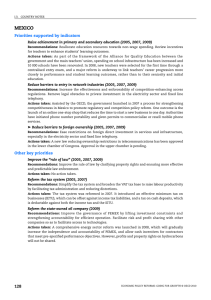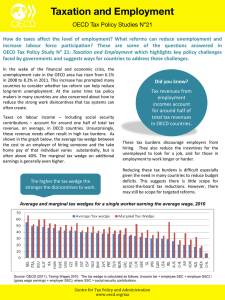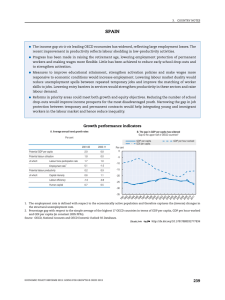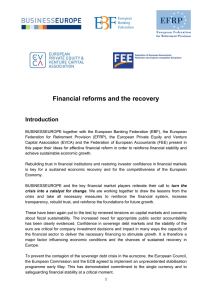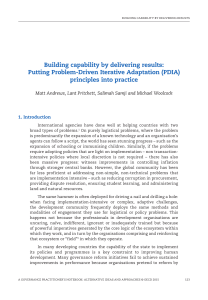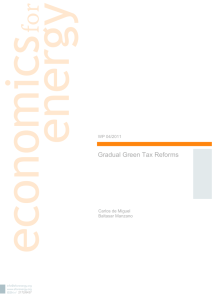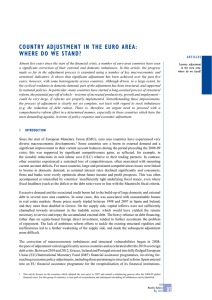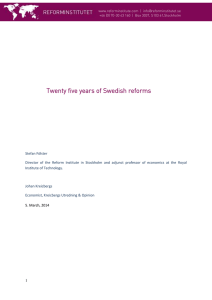Executive summary
Anuncio
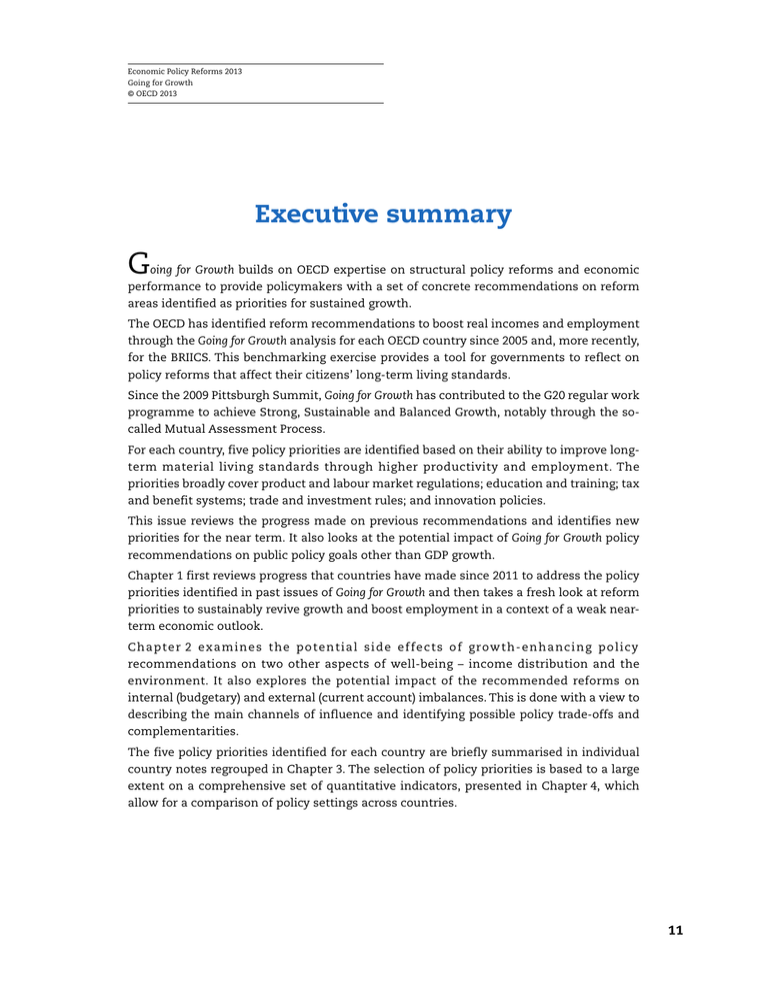
Economic Policy Reforms 2013 Going for Growth © OECD 2013 Executive summary G oing for Growth builds on OECD expertise on structural policy reforms and economic performance to provide policymakers with a set of concrete recommendations on reform areas identified as priorities for sustained growth. The OECD has identified reform recommendations to boost real incomes and employment through the Going for Growth analysis for each OECD country since 2005 and, more recently, for the BRIICS. This benchmarking exercise provides a tool for governments to reflect on policy reforms that affect their citizens’ long-term living standards. Since the 2009 Pittsburgh Summit, Going for Growth has contributed to the G20 regular work programme to achieve Strong, Sustainable and Balanced Growth, notably through the socalled Mutual Assessment Process. For each country, five policy priorities are identified based on their ability to improve longterm material living standards through higher productivity and employment. The priorities broadly cover product and labour market regulations; education and training; tax and benefit systems; trade and investment rules; and innovation policies. This issue reviews the progress made on previous recommendations and identifies new priorities for the near term. It also looks at the potential impact of Going for Growth policy recommendations on public policy goals other than GDP growth. Chapter 1 first reviews progress that countries have made since 2011 to address the policy priorities identified in past issues of Going for Growth and then takes a fresh look at reform priorities to sustainably revive growth and boost employment in a context of a weak nearterm economic outlook. C h a p t e r 2 ex a m i n e s t h e p o t e n t i a l s i d e e f f e c t s o f g row t h - e n h a n c i n g p o l i cy recommendations on two other aspects of well-being – income distribution and the environment. It also explores the potential impact of the recommended reforms on internal (budgetary) and external (current account) imbalances. This is done with a view to describing the main channels of influence and identifying possible policy trade-offs and complementarities. The five policy priorities identified for each country are briefly summarised in individual country notes regrouped in Chapter 3. The selection of policy priorities is based to a large extent on a comprehensive set of quantitative indicators, presented in Chapter 4, which allow for a comparison of policy settings across countries. 11 EXECUTIVE SUMMARY Key policy messages Policy reform progress and priorities 12 ● For OECD countries, action on priorities stands at its highest levels since the start of the Going for Growth exercise, reflecting the growing recognition of the need for structural reforms to restore competitiveness and fiscal sustainability, conditions for a return to a healthy post-crisis growth path. ● The pace of reforms has been particularly high in euro area countries under financial assistance programmes or direct market pressures (e.g. Greece, Ireland, Italy, Portugal and Spain), including in politically-sensitive areas such as labour regulation and welfare systems. These countries are also implementing significant fiscal consolidation programmes. This contrasts with the much more moderate pace of reforms in other euro area countries, in particular those with a current account surplus, as well as in countries enjoying highest living standards (e.g. Norway, Switzerland and the United States). Yet, more active reforms in these countries would help achieve rebalancing, both within the euro area and more globally. It would also help support the credibility of fiscal consolidation plans. ● Action on priorities has been relatively high in Central European countries but more moderate on average across the BRIICS, reflecting in part the milder crisis-induced pressures to reform in these countries. Even so, progress has been achieved in reducing the scope of state control on businesses, in improving the transparency of product market regulation, and in strengthening basic education systems. ● Comparing the 2011 and 2013 Going for Growth priorities, the most notable change is a marked increase in the share of priorities aimed at boosting employment for OECD countries, especially in the areas of social benefits and active labour market policies, reflecting the growing focus on dealing with the job market legacy of the post-crisis weak recovery and associated challenges of helping unemployed people returning to work. The stronger emphasis on active labour market and social benefit policies is largely consistent with countries’ own structural reform commitments and core priorities, as expressed in the context of the G20 action plans. ● Especially in the euro area, the need to reduce unemployment remains a pressing challenge. Recommendations to reform tax and benefit systems, active labour market policies and job protection legislation are therefore quite common, even though product market reforms also feature prominently, not least in services sectors where they can deliver fairly rapid employment gains. In the remaining relatively wealthy OECD countries, in particular Japan and Korea, there is greater emphasis on boosting labour productivity, and the focus is on reforming network sector regulations, tax structures, FDI restrictions and agricultural subsidies. Reforming the tax structure is also a priority for the United States, along with the need to improve efficiency and equity in the education and health sectors. ● For lower-income countries such as Mexico, Turkey and the BRIICS, growth has generally been strong until more recently, but one set of common challenges concerns the quality and inclusiveness of education systems, the capacity and regulation of infrastructures and the prevalence of high barriers to competition and investment, for both domestic and foreign firms. Labour informality also imposes economic and social damage in most of these countries, and there are a number of recommendations e.g. in the areas of tax and benefit systems and job protection aimed at reducing the extent of informal employment. ECONOMIC POLICY REFORMS 2013: GOING FOR GROWTH © OECD 2013 EXECUTIVE SUMMARY Potential side effects of growth-enhancing reforms ● Many of the policy changes recommended for growth are found to either help with achieving other well-being objectives or to have no clear impact. Still, a number of recommendations may conflict with re-distributional or environmental objectives and policymakers must be aware of such trade-offs in order to design policy packages that best meet their objectives. ● Shifting the tax mix away from direct taxes towards consumption, environmental and real estate taxation, such as recommended for many countries as a means to improve work and investment incentives, could clash with equity objectives, unless accompanying measures are designed to alleviate or minimise the adverse impacts on income distribution. ● Measures in the areas of employment protection legislation, wage bargaining institutions and the minimum wage, which are recommended to improve employment opportunities for low-skilled workers and young people, may widen the wage distribution and thus exacerbate income inequality in the short run. This effect, however, may be partly or even fully offset in the longer run as job prospects brighten for such workers, especially those weakly attached to the labour market. ● Reforms that boost economic activity will in general put stronger pressures on environmental resources, for instance through rising greenhouse gas emissions, waste production or water abstraction. Nonetheless, some of the recommendations will also help to make future GDP growth more sustainable by raising the production costs of environmentally-harmful activities. This is the case notably of recommendations to shift taxation from labour to pollution emissions. Also, reforms that promote greater competition in markets for goods and services and facilitate resource reallocation will underpin the effectiveness of market-based environmental instruments by raising the responsiveness to price signals. ● Growth-enhancing structural reforms have a direct, short-term impact on government budgets when their implementation requires additional public resources or – less frequently – entails initial expenditure cutbacks or revenue increases. In the longer term, the effect of structural reforms on the budget will differ mainly according to whether they boost growth through employment or productivity. In both cases, reforms generate higher tax revenues, but only in the case of employment are they likely to significantly improve the budget balance. ● Reform action to reduce obstacles to full-time female labour force participation and regulatory barriers to entry in specific sectors such as recommended for a number of external surplus countries would weaken the current account position by reducing saving and boosting investment. Conversely, policy measures more likely to strengthen the current account include reforms that raise competitiveness of export-oriented sectors through changes in taxation or stronger exposure to domestic competition. ECONOMIC POLICY REFORMS 2013: GOING FOR GROWTH © OECD 2013 13
